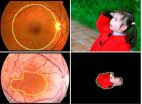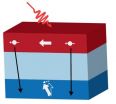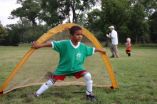(Press-News.org) NEW YORK, NY (July 10, 2014) — Columbia University Medical Center (CUMC) researchers have created a way to develop personalized gene therapies for patients with retinitis pigmentosa (RP), a leading cause of vision loss. The approach, the first of its kind, takes advantage of induced pluripotent stem (iPS) cell technology to transform skin cells into retinal cells, which are then used as a patient-specific model for disease study and preclinical testing.
Using this approach, researchers led by Stephen H. Tsang, MD, PhD, showed that a form of RP caused by mutations to the gene MFRP (membrane frizzled-related protein) disrupts the protein that gives retinal cells their structural integrity. They also showed that the effects of these mutations can be reversed with gene therapy. The approach could potentially be used to create personalized therapies for other forms of RP, as well as other genetic diseases. The paper was published recently in the online edition of Molecular Therapy, the official journal of the American Society for Gene & Cell Therapy.
"The use of patient-specific cell lines for testing the efficacy of gene therapy to precisely correct a patient's genetic deficiency provides yet another tool for advancing the field of personalized medicine," said Dr. Tsang, the Laszlo Z. Bito Associate Professor of Ophthalmology and associate professor of pathology and cell biology.
While RP can begin during infancy, the first symptoms typically emerge in early adulthood, starting with night blindness. As the disease progresses, affected individuals lose peripheral vision. In later stages, RP destroys photoreceptors in the macula, which is responsible for fine central vision. RP is estimated to affect at least 75,000 people in the United States and 1.5 million worldwide.
More than 60 different genes have been linked to RP, making it difficult to develop models to study the disease. Animal models, though useful, have significant limitations because of interspecies differences. Researchers also use human retinal cells from eye banks to study RP. As these cells reflect the end stage of the disease process, however, they reveal little about how the disease develops. There are no human tissue culture models of RP, as it would dangerous to harvest retinal cells from patients. Finally, human embryonic stem cells could be useful in RP research, but they are fraught with ethical, legal, and technical issues.
The use of iPS technology offers a way around these limitations and concerns. Researchers can induce the patient's own skin cells to revert to a more basic, embryonic stem cell–like state. Such cells are "pluripotent," meaning that they can be transformed into specialized cells of various types.
In the current study, the CUMC team used iPS technology to transform skin cells taken from two RP patients—each with a different MFRP mutation—into retinal cells, creating patient-specific models for studying the disease and testing potential therapies.
By analyzing these cells, the researchers found that the primary effect of MFRP mutations is to disrupt the regulation of actin, the protein that makes up the cytoskeleton, the scaffolding that gives the cell its structural integrity. "Normally, the cytoskeleton looks like a series of connected hexagons," said Dr. Tsang. "If a cell loses this structure, it loses its ability to function."
The researchers also found that MFRP works in tandem with another gene, CTRP5, and that a balance between the two genes is required for normal actin regulation.
In the next phase of the study, the CUMC team used adeno-associated viruses (AAVs) to introduce normal copies of MFRP into the iPS-derived retinal cells, successfully restoring the cells' function. The researchers also used gene therapy to "rescue" mice with RP due to MFRP mutations. According to Dr. Tsang, the mice showed long-term improvement in visual function and restoration of photoreceptor numbers.
"This study provides both in vitro and in vivo evidence that vision loss caused by MFRP mutations could potentially be treated through AAV gene therapy," said coauthor Dieter Egli, PhD, an assistant professor of developmental cell biology (in pediatrics) at CUMC, who is also affiliated with the New York Stem Cell Foundation.
Dr. Tsang thinks this approach could also be used to study other forms of RP. "Through genome-sequencing studies, hundreds of novel genetic spelling mistakes have been associated with RP," he said. "But until now, we've had very few ways to find out whether these actually cause the disease. In principle, iPS cells can help us determine whether these genes do, in fact, cause RP, understand their function, and, ultimately, develop personalized treatments."
INFORMATION:
Patient-specific stem cells and personalized gene therapy
Vision loss patients' own cells transformed into model for studying disease and developing potential treatment
2014-07-10
ELSE PRESS RELEASES FROM THIS DATE:
Men's hot flashes: Hypnotic relaxation may ease the discomfort men don't talk about
2014-07-10
WACO, Texas (July 10, 2014) — Men who experience hot flashes are unlikely to talk much about it, but they may find relief from their silent suffering if they are willing to try an unusual treatment, according to findings from a Baylor University case study.
After seven weeks of hypnotic relaxation therapy, a 69-year-old man who had uncontrolled hot flashes following prostate cancer surgery showed a drastic decrease not only in hot flashes but also an impressive improvement in sleep quality, according to the study.
The Baylor study — funded by the National Institutes ...
New research identifies risk factors for little league shoulder
2014-07-10
SEATTLE, WA – As cases of Little League Shoulder (LLS) occur more frequently, the need for additional information about the causes and outcomes of the condition has become clear. Researchers presenting at the American Orthopaedic Society for Sports Medicine's (AOSSM) Annual Meeting today shared new data identifying associated risk factors, common treatment options and return to play.
"Our study examined 95 patients ranging from 8-17 years old diagnosed with Little League Shoulder," commented Benton E. Heyworth, MD, corresponding author from Children's Hospital Boston, ...
Entering MLB early may increase elbow surgery risk
2014-07-10
SEATTLE, WA – The common elbow surgery made famous by Major League Baseball (MLB) pitcher, Tommy John, definitely does its job to return pitchers to the mound, but risks for having the surgery may be able to be recognized earlier in a player's career, say researchers presenting their work at the American Orthopaedic Society for Sports Medicine's (AOSSM) Annual Meeting today. The study was the largest cohort of MLB pitchers, to date, that have undergone UCL reconstruction.
"Our results suggest that UCL reconstructive surgery does a tremendous job in allowing players to ...
Young athletes should consider the benefits of ACL surgery
2014-07-10
SEATTLE, WA – Young patients who wait for ACL surgery may be at increased risk for secondary knee injuries, according to research presented today at the American Orthopaedic Society for Sports Medicine's (AOSSM) Annual Meeting. The study adds to existing research noting the risk of secondary meniscal and chondral injuries in pediatric patients.
"In reviewing records of young patients who received ACL reconstructions, our data showed higher rates and severity of secondary meniscus injuries when surgery is delayed," noted lead author Allen F. Anderson, MD, from the Tennessee ...
Intercollegiate contact athletes with shoulder instability return to in-season sports
2014-07-10
SEATTLE, WA – College athletes experiencing in-season shoulder instability regularly return to play within one week of injury, but developed recurrent instability in 63% of cases, according to research presented today at the American Orthopaedic Society for Sports Medicine's (AOSSM) Annual Meeting. This latest information may help guide team physicians in providing the most optimal treatment plans for injured players.
"We examined 45 athletes who suffered an anterior shoulder instability event, and found that 33 (73%) returned to play for at least part of the season after ...
Stabilizing shoulder surgery helps NFL players return to the game
2014-07-10
SEATTLE, WA – Shoulder instability is a common injury in football players but the rate of return to play has not been regularly determined following surgery. A new study, discussed at the American Orthopaedic Society for Sports Medicine's (AOSSM) Annual Meeting today details that return rates for NFL players is approximately 90 percent no matter what the stabilization procedure (open vs. arthroscopic).
"Our study highlighted the success rate of return to play following shoulder stabilization surgery. Age, number of games before surgery, and career length were not statistically ...
University of Illinois study advances limits for ultrafast nano-devices
2014-07-10
A recent study by researchers at the University of Illinois at Urbana-Champaign provides new insights on the physical mechanisms governing the interplay of spin and heat at the nanoscale, and addresses the fundamental limits of ultrafast spintronic devices for data storage and information processing.
"Electrons carry a charge as well as spin-angular momentum. In a typical charge current, electrons' spin-angular-momentum is random so there is no spin current," explained David Cahill, a professor of materials science and engineering at Illinois. "However when electrons ...
Speeding up data storage by a thousand times with 'spin current'
2014-07-10
A hard drive stores bits in the form of tiny magnetic domains. The directions of the magnetic north and south poles of these domains, which are referred to as the magnetization, determine whether they are a 0 or a 1. Data is stored by changing the direction of the magnetization of the associated bits. At present this is done using a write head to create a local magnetic field, which makes a bit change direction.
Limit reached
The stronger the local magnetic field, the faster the switch takes place. But this is subject to a limit which has now almost been reached. "The ...
Being a good sport ranks as the top 'fun' factor in study of youth sports
2014-07-10
WASHINGTON, DC (July 10, 2014) — If you think winning is one of the key determinants that makes organized sports fun for kids think again: Winning along with other mental bonuses ranked near the bottom of 81 determinants of fun, each of which falls into one of 11 big fun factors, according to a new study. Despite the common belief that winning is all important when it comes to the "fun" factor, very little research had been done to actually identify and quantify what goes into this elusive concept—until now.
The results of this study might help researchers develop proven ...
Go play outside! Outdoor time promotes physical activity in youth
2014-07-10
Cincinnati, OH, July 10, 2014 -- The World Health Organization recommends that youth participate in a minimum of 60 minutes of moderate to vigorous physical activity (MVPA) each day. Studies have shown that youth experience most of their MVPA during school hours. Therefore, it stands to reason that increasing outdoor time after school hours would increase MVPA. In a new study scheduled for publication in The Journal of Pediatrics, researchers confirmed that time spent outdoors after school was positively associated with MVPA.
Drs. Lee Schaefer and Jonathan McGavock, ...
LAST 30 PRESS RELEASES:
Electrons lag behind the nucleus
From fungi to brain cells: one scientist's winding path reveals how epigenomics shapes neural destiny
Schizophrenia and osteoporosis share 195 genetic loci, highlighting unexpected biological bridges between brain and bone
Schizophrenia-linked genetic variant renders key brain receptor completely unresponsive to both natural and therapeutic compounds
Innovative review reveals overlooked complexity in cellular energy sensor's dual roles in Alzheimer's disease
Autism research reframed: Why heterogeneity is the data, not the noise
Brazil's genetic treasure trove: supercentenarians reveal secrets of extreme human longevity
The (metabolic) cost of life
CFRI special issue call for papers: New Frontiers in Sustainable Finance
HKU Engineering scholar demonstrates the smallest all-printed infrared photodetectors to date
Precision empowerment for brain "eavesdropping": CAS team develops triple-electrode integrated functional electrode for simultaneous monitoring of neural signals and chemical transmitters during sleep
Single-capillary endothelial dysfunction resolved by optoacoustic mesoscopy
HKU three research projects named among ‘Top 10 Innovation & Technology News in Hong Kong 2025’ showcasing excellence in research and technology transfer
NLRSeek: A reannotation-based pipeline for mining missing NLR genes in sequenced genomes
A strand and whole genome duplication–aware collinear gene identification tool
Light storage in light cages: A revolutionary approach to on-chip quantum memories
Point spread function decoupling in computational fluorescence microscopy
BacPhase: Long-insert paired-end sequencing for bin marker construction and genome phasing
GmWOX1 regulates the mediolateral polarity of compound leaves in soybean
ChargeFabrica: An open-source simulation tool that aims to accelerate search for high performance perovskite solar cells
High levels of ADAR overexpression induce abundant and stochastic off-target RNA editing in rice protoplasts
On-demand upgraded recycling of polyethylene and construction of sustainable multifunctional materials based on the "LEGO" strategy
New "Stomata in-sight" system allows scientists to watch plants breathe in real-time
Anorexia nervosa may result in long-term skeletal muscle impairment
Narrative-based performance reviews deemed fairest by employees
New insights reveal how advanced oxidation can tackle emerging water pollutants
New review shows how biomass can deliver low-carbon gaseous fuels at scale
Climate change is quietly rewriting the world’s nitrogen cycle, with high stakes for food and the environment
Study finds SGLT-2 inhibitors linked to lower risk of diabetic foot nerve damage
Microbes may hold the key to brain evolution
[Press-News.org] Patient-specific stem cells and personalized gene therapyVision loss patients' own cells transformed into model for studying disease and developing potential treatment





